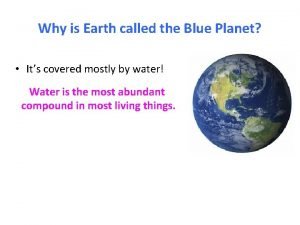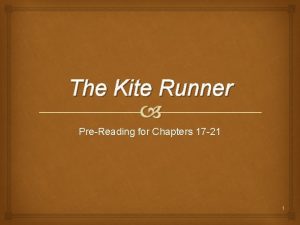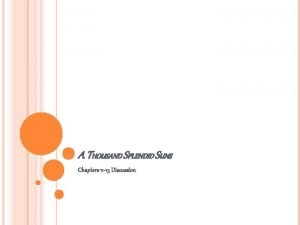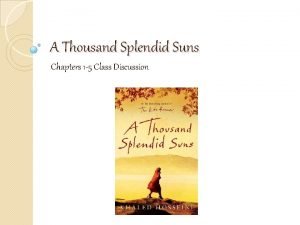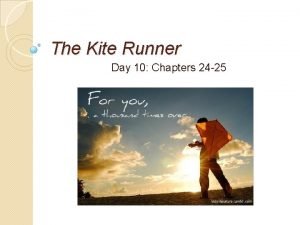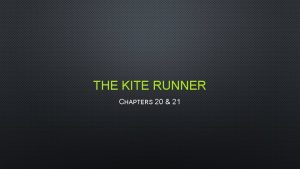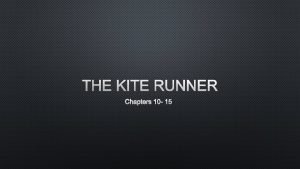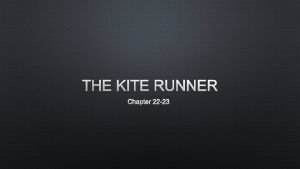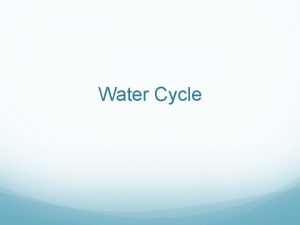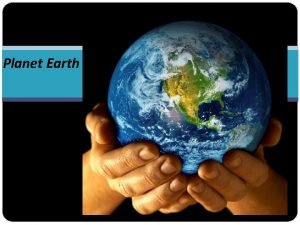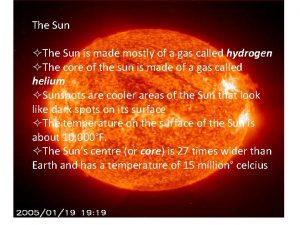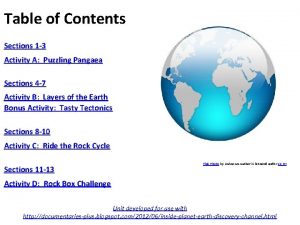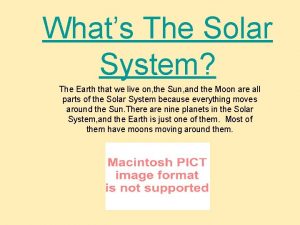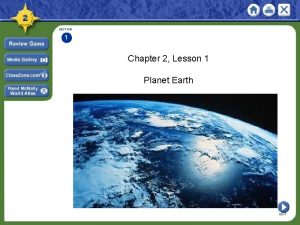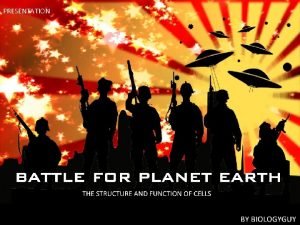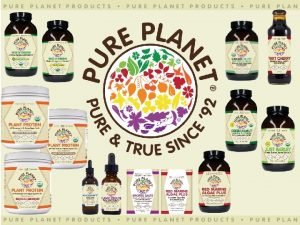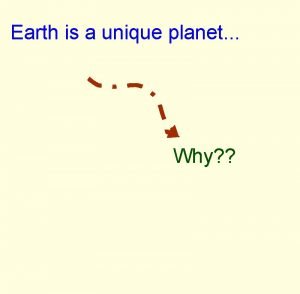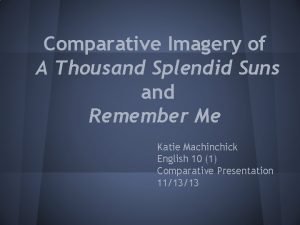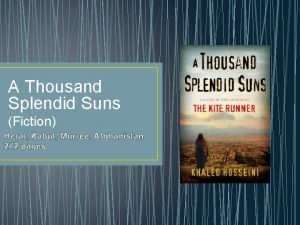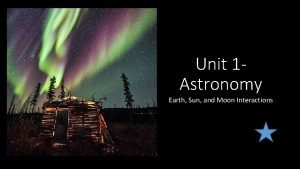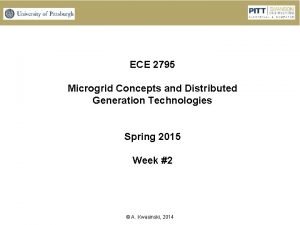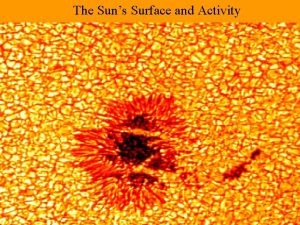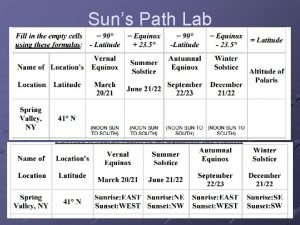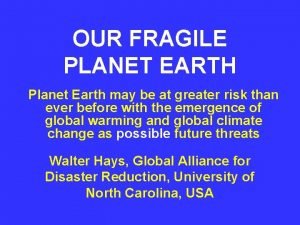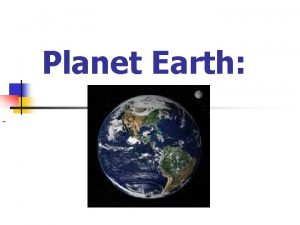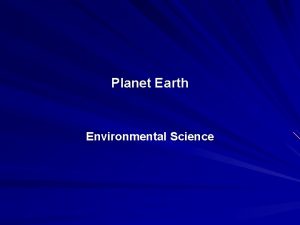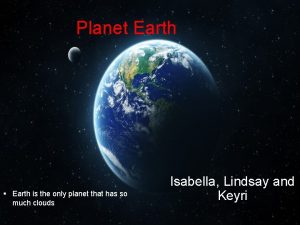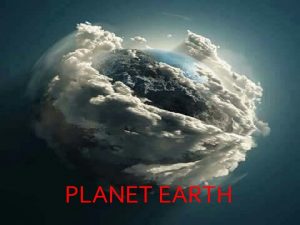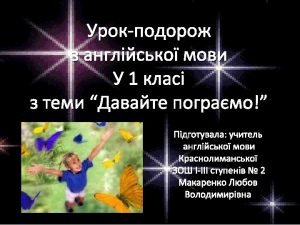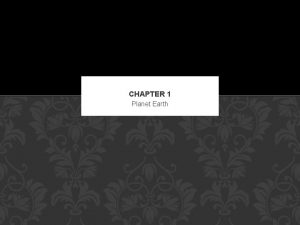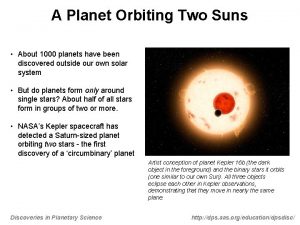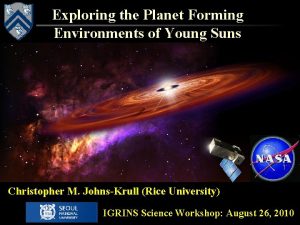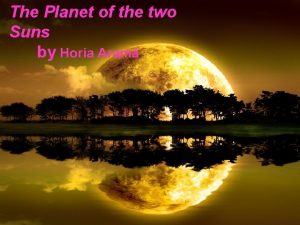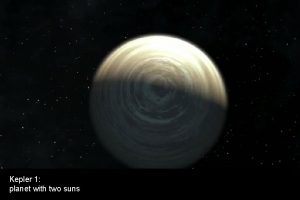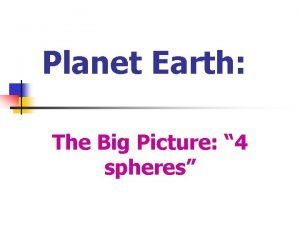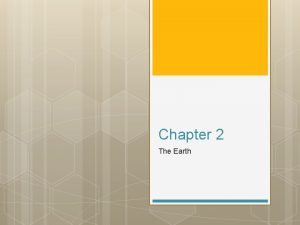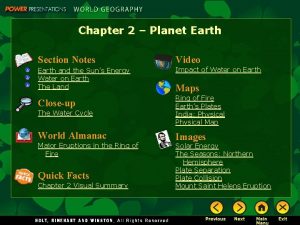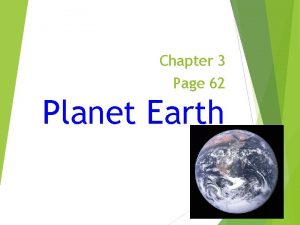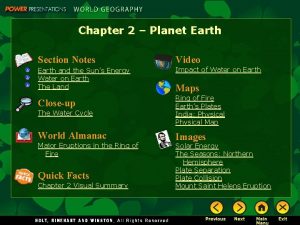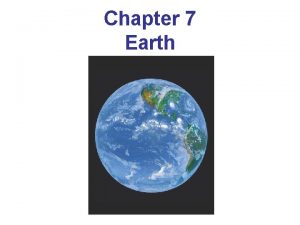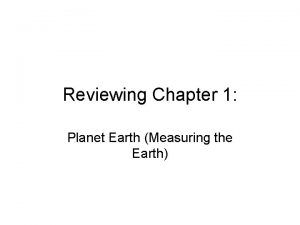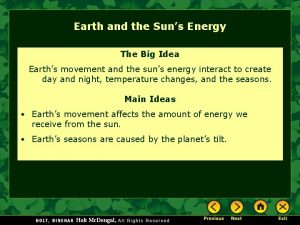Planet Earth Chapter 2 Earth and the Suns
























- Slides: 24

Planet Earth Chapter 2

Earth and the Sun’s Energy Section 1

Earth’s Movements • All life on Earth requires solar energy • Amount of solar energy is constantly changing because of the Earth’s rotation, revolution, and tilt. • Rotation • Earth’s axis is an imaginary rod that runs from the north pole to the south pole • As it spins a different part of the planet faces the sun • It takes 24 hours to complete this rotation • The sun remains stationary as the Earth turns. 3

• Revolution • As the Earth spins on its axis it also follows an orbit around the sun. • The orbit is an ellipse – sometimes Earth is closer to the sun and sometimes it is farther. • It takes 365 ¼ days for Earth to complete one revolution. • February 29 is added to the calendar every 4 years • Tilt and Latitude • Earth is tilted on its axis 23 ½ degrees. • At any given time of the year, some locations are tilted towards the sun and others are tilted away • This creates winter and summer • Places in a lower latitude, or close to the equator, receive direct rays from the sun all year long 4

The Seasons • Winter and Summer • Change in seasons is created by Earth’s tilt. • Winter occurs on parts of Earth that are tilted away from the sun get less direct solar energy, cool temperatures, and less daylight • Vice versa for summer. • Because of Earth’s tilt, the Northern and Southern hemispheres experience opposite seasons. 5

• Spring and Fall • As Earth orbits the sun, there are periods when the poles tilt neither towards or away from the sun. • These periods mark spring and fall. • Rainfall and Seasons • Some regions have seasons marked by rainfall instead of temperatures. • The tropics experience these seasons. • Winds bring dry or moist air into the region and create wet and dry seasons. 6

Water on Earth Section 2

Earth’s Water Supply • Water covers two-thirds of the Earth • 97% is salt water – unsafe to drink • Most salt water is found in the oceans • Some lakes also contain salt water • Great Salt Lake, UT • Freshwater makes up only 3% of the Earth’s water supply. • Much of the freshwater is in Earth’s glaciers, and in the ice in the Arctic and Antarctic • The water we use everyday is found in lakes, rivers, and under the Earth’s surface. 8

• Surface water is in streams, rivers, and lakes. • Less than 1% of our water supply comes from surface water. • Streams form from precipitation and join together to form rivers. • Some lakes are formed as rivers fill lowlying areas • Others are formed by glaciers carving deep holes in the Earth’s surface • Ex: Great Lakes • Most of our available freshwater is groundwater. • Groundwater is typically obtained by drilling into the ground. 9

The Water Cycle • Water occurs as a solid, a liquid, and a gas. • Water vapor is the invisible gas in the air. • Water is always moving on Earth. • The water cycle is this movement • The Sun’s energy drives the water cycle. • Because the cycle is constantly repeating, the supply of water on Earth remains fairly constant. 10

• The cycle 1. Sun heats water on the Earth’s surface 2. Water turns into water vapor 3. Vapor rises into the air and cools 4. Vapor changes into droplets and these droplets join together to form clouds. 5. If the droplet becomes heavy enough, precipitation occurs. 6. The precipitation falls to Earth’s surface and is absorbed into groundwater or runs off into bodies of water. 11

Water and People • Water is crucial for survival • Many places on Earth face water shortages • Lack of fresh water • Droughts • Overuse • Polluted water • Flooding is another water problem • Flooding can cause property damage and threatens lives • Water also provides food, power, and recreation 12

The Land Section 3

Landforms • Landforms are shapes on the planet’s surface that make up the landscapes that surround us. • Mountains – rises higher than 2000 ft • Valleys – areas of low land located between mountains or hills • Plains – stretches of mostly flat land • Islands – areas of land completely surrounded by water • Peninsulas – land surrounded by water on three sides 14

Forces below Earth’s Surface • The planet is made up of three layers. • Solid inner core, liquid mantle, solid crust • Continents are part of the Earth’s crust. • Plate tectonics suggests that Earth’s surface is divided into a dozen slowmoving plates • Use this to explain our landforms • Energy deep inside the Earth puts pressure on Earth’s crust and forces the plates to shift. • Plates move in different directions and at different speeds. 15

Movement of Continents • Plates move slowly – up to several inches per year • Over 200 million years we see that continents have moved a long distance • Alfred Wegener developed theory of continental drift • Earth’s plates shifted over million of years • Plates are still moving today • They collide, separate, or slide past one another • These movements have shaped our landforms 16

Plates Collide • Collision of plates create ocean trenches and mountains • When 2 ocean plates collide, one plate pushes under the other. • This creates an ocean trench, or deep valley in the ocean floor • The deepest ocean trench is near Japan and the pacific plate moves under other plates – Mariana Trench • When an ocean plate and a continental plate collide the ocean plate drops beneath the continental plate. • Causes a mountain range • The Andes in South America formed when the South American plate and the Nazca plate collided. 17

• When 2 continental plates collide large mountains are formed. • The Himalayas were formed when the Indian plate crashed into the Eurasian plate. • The Himalayas continue to grow as the two plates keep crashing into one another. 18

Plates Separate • As plates move apart, gaps between the plates allow magma to rise to the crust. • Lava emerges from the gap and as it cools it builds a mid-ocean ridge, or underwater mountain. • Separation of the North American and Eurasian plats formed the Mid-Atlantic Ridge. • If the mountains rise high enough they form volcanic islands - Iceland 19

Plates Slide • Tectonic plates can slide past one another. • This sliding causes earthquakes. • Earthquakes usually take place along faults. • The San Andreas Fault zone in California is a place where earthquakes are quite common. • North American plate and Pacific plate • The pacific plate is known as the Ring of Fire because it is home to most of the world’s earthquakes and volcanoes. 20

Forces on Earth’s Surface • Weathering • Rock is broken down into smaller pieces • Heat and water can cause rocks to crack or wash away • The small pieces of rock are known as sediment • Wind, ice, and water often move sediment 21

• Erosion • Movement of sediment from one location to another • Can wear away or build up landforms • Powerful winds often cause erosion • Glaciers can cause massive erosion by melting and carving out a path for the water • Water is the most common cause of erosion • Waves can wear away at the coastline • Flowing water carves out new paths • The Grand Canyon 22

23

Landforms influence Life • Earth’s landforms affect our settlement and cultures • In early times people settled near deltas for easy transportation and fertile soil • Earliest settlement between the Tigris and Euphrates • Some landforms also discourage settlements • People also change landforms to suit their needs. 24
 Why the earth is called blue planet
Why the earth is called blue planet A thousand splendid suns chapter 17
A thousand splendid suns chapter 17 Chapter 13 a thousand splendid suns
Chapter 13 a thousand splendid suns Fictional character chap 1
Fictional character chap 1 Kite runner chapter 24
Kite runner chapter 24 Kite runner 20-21
Kite runner 20-21 The kite runner chapter 15
The kite runner chapter 15 Kite runner chapter 22
Kite runner chapter 22 Planet earth and beyond grade 7
Planet earth and beyond grade 7 Condensation in the water cycle
Condensation in the water cycle Does the sun moves
Does the sun moves The sun is made mostly of
The sun is made mostly of Why is mantle material compared to the consistency of fudge
Why is mantle material compared to the consistency of fudge Whats the biggest planet in the solar system
Whats the biggest planet in the solar system Lesson 1 planet earth
Lesson 1 planet earth What is this
What is this Pure planet fulvic zeolite
Pure planet fulvic zeolite Why is the earth called unique planet
Why is the earth called unique planet Personification in a thousand splendid suns
Personification in a thousand splendid suns Thousand splendid suns theme
Thousand splendid suns theme Afghanistan
Afghanistan Figurative language in kite runner
Figurative language in kite runner Suns layers
Suns layers Suns position
Suns position John hay splendid little war
John hay splendid little war
